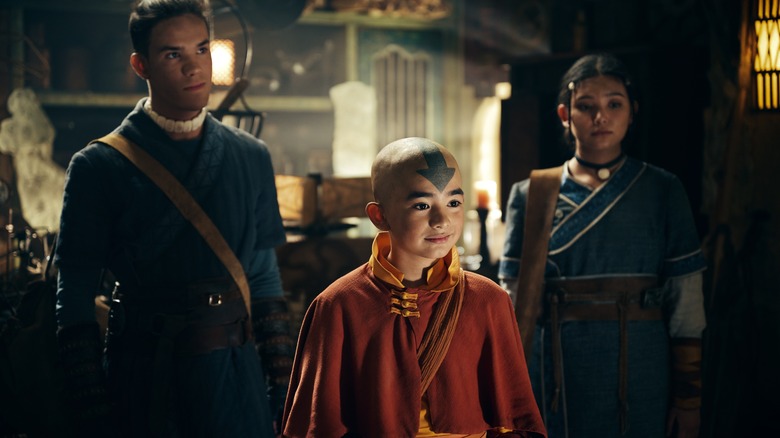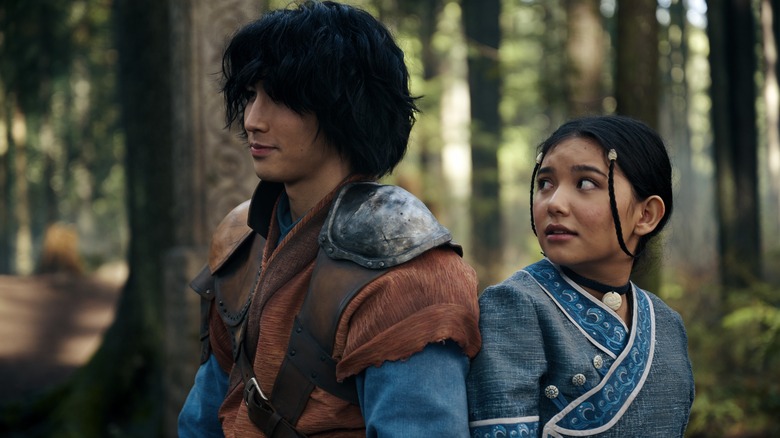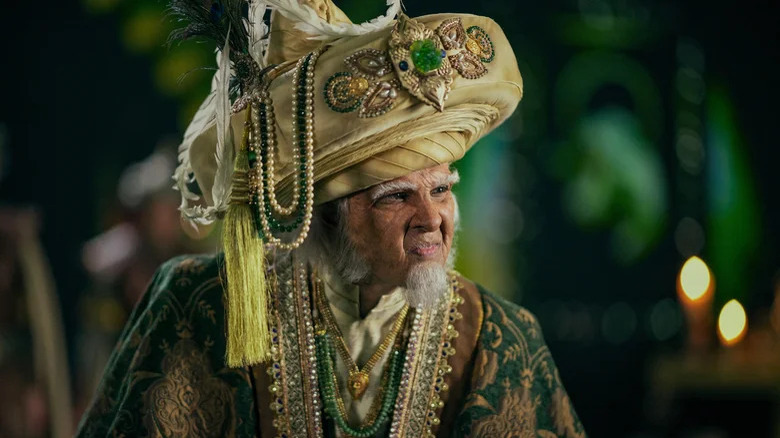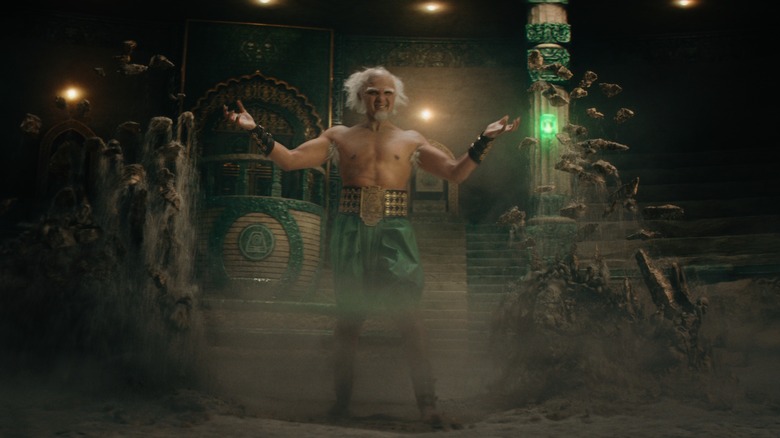Netflix Changes Avatar: The Last Airbender's Omashu Completely - And It's Not Good
Every episode of Netflix's live-action "Avatar: The Last Airbender" adaptation makes major changes to the source material, from Avatar Kyoshi (Yvonne Chapman) inhabiting Aang (Gordon Cormier) for a big action sequence to Uncle Iroh (Paul Sun-Hyung Lee) being the one to kill Admiral Zhao (Ken Leung). No part of the story receives bigger changes than the Omashu chapter, however. And while the new show's attempt at combining multiple plot threads from the original series is admirable, it ultimately hurts some of the most beloved "Avatar" characters.
For the sake of time, and to better fit the hour-long episodes of the Netflix adaptation, Aang, Katara (Kiawentiio), and Sokka (Ian Ousley) visit Omashu over the course of two episodes. They not only meet King Bumi (Utkarsh Ambudkar), the star of the cartoon's "The King of Omashu" episode, but also Jet (Sebastian Amoruso), Sai (Danny Pudi), and Teo (Lucian-River Chauhan). By twisting these characters' stories around, Netflix forms them into a giant Omashu mush — one that sadly diminishes each respective arc.
Characters are rewritten in baffling ways — especially Bumi — and the lack of focus on any individual storyline weakens a lot of the motivations. Making Omashu a more central piece of live-action "Avatar: The Last Airbender" makes sense, but the execution just isn't there to bring all the different pieces together.
Jet and the mechanist are cheapened in Omashu
Both Jet and Sai are the stars of their own episodes in the original "Avatar" cartoon, with Jet debuting in a self-titled episode and Sai and Teo popping up in "The Northern Air Temple." It's understandable why the live-action team wanted to cut some of these extraneous adventures, but the series fails to implement sufficient new material in Omashu to properly convey these characters' arcs.
In the original show, Jet is fighting the Fire Nation in the middle of nowhere. He and his gang live in a forest because their land has been conquered, and they're fighting an active occupation. His extremism is revealed via his plan to flood a local village, killing both innocent Earth Kingdom civilians as well as the Fire Nation soldiers inside. It's a deplorable but understandable escalation. In the live-action series, Jet and his crew are camping roughly 30 yards beyond the Omashu walls. They're ostensibly combating "corruption" in King Bumi's court, but we never see any signs of this supposed rot. Jet comes off simply as an unstable person fighting his own countrymen, rather than a radical driven to extreme measures. As a result, his arc falls flat.
Sai and Teo suffer a similar fate. We never see them interact with Bumi, so Sai's new role as court mechanist doesn't feel grounded. In the animated series, both characters embody the inescapable march of supposed technological progress. That theme fails to materialize here, and there's so much else happening in Omashu that they barely get time to be characters.
King Bumi is twisted into a cruel old man
King Bumi is undoubtedly one of the most beloved characters in "Avatar: The Last Airbender." He's a kooky old man, a playful friend, a baffling monarch, and one of the most powerful earthbenders in the entire world. But above all of that, he's a caring person. The trials he puts Aang through in the cartoon may seem dangerous, but Bumi's in control the whole time. His methods may be strange, but he proves himself repeatedly to be a compassionate person with a deep spiritual center of peace and patience.
Other than the fact that he still munches on lettuce leaves, the live-action Bumi is practically unrecognizable. Aang discovers that Bumi's his old friend immediately this time, but that doesn't stop the ruler from being uncharacteristically vicious toward him. Their fight is a true fight to the death, which ends with Bumi urging Aang to choose which one of them will live. It's a true Willem Dafoe Green Goblin moment, only awkwardly defused by the sudden appearance of Katara and Sokka.
This version of Bumi isn't just different. It's the opposite of the original and a categorical misunderstanding of the character. In the cartoon, Bumi is the primary spokesperson of "neutral jing," an earthbending principle that dictates "waiting and listening for the right moment to strike." Yet in the Netflix show, Bumi tells Aang, "Sometimes you have to fight even when you don't want to. That's what it means to be in a war." Most of the character changes in the Netflix show are at least understandable, but the new Bumi couldn't be further from his original, lovable form.
Netflix's Avatar shouldn't have used the secret tunnel so soon
The cherry on top of the Netflix Omashu mess is that the Cave of Two Lovers is thrown into the mix with everything else. In the animated series, "The Cave of Two Lovers" is the second episode of Season 2. The titular cave and tunnel network leading into Omashu isn't used until the gang's second visit to the city, after a journey to the Northern Water Tribe. However, Netflix's take sees Sokka and Katara use the tunnels to help free Aang from the suddenly malicious King Bumi, bumping the cave up much earlier in the "Avatar" timeline.
This change means that Aang and Katara are robbed of one of their key love story beats, as the two share a kiss in tunnels on the animated show. That also leads to the odd choice to have Katara share the tunnel with her brother. The most likely explanation for this change is so the series could find a way to include the heavily memed "Secret Tunnel" song in Season 1. After all, what would a modern franchise show be without every possible Easter egg squeezed into the cracks? Like with many of the Omashu changes, the intentions were probably good, but it's hard to look favorably at the end result.



